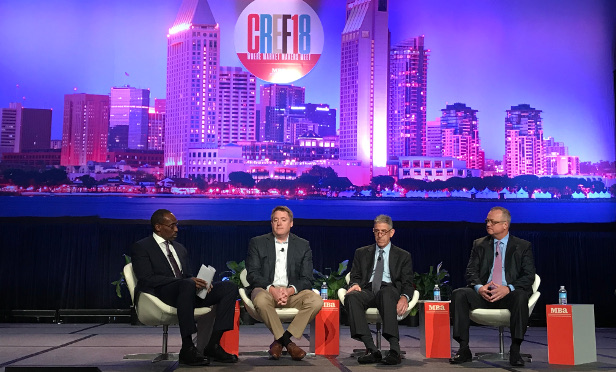
SAN DIEGO—With more major diversified financial institutions appearing to be taking ownership stakes in debt funds, mortgage-banking firms and technology platforms, the waters are growing murkier for those that have been in this space for some time, panelists at MBA CREF/Multifamily told attendees here Tuesday. The session “Capital Source Convergence: Are the Lines Among Financing Sources Becoming Blurred?” explored the divergent business models that are shaping the formation and ownership structures of active market participants and how intermediaries and lenders are viewing the future and accessing less-traditional financing sources and deliver models to match borrowers with lenders.
Daniel Baker, EVP of KeyBank Real Estate Capital, said with more entrants into the debt space, the market has become more competitive, and Jeff Friedman, co-founder of Mesa West Capital LLC—which is in negotiations to be acquired by Morgan Stanley—agreed, saying “I wish everyone would leave my block—I was there first!” He said his firm had a “lemonade stand” that was profitable, and now there are 40 “lemonade stands,” so his company's visibility is horrible. Why have all these new funds emerged? “The search for yield by institutional investors, and the fundamentals of this space have been great. Current income and downside protection is what debt funds can offer, and the flood of capital is driving down costs.”
Baker said banks are struggling for loan growth and are fighting competitors on pricing, not on underwriting standards, and Friedman said life companies are also growing in the debt-fund space.
Mark Williams, managing director for Eastdil Secured, said the makeup for debtors hasn't changed much, but competition from debt funds is tightening spreads.
Friedman pointed out that before CMBS, borrowers would borrow from life companies and the S&Ls. Defeasance was a brand-new concept—a new vehicle for the ecosystem—that grew, and “you had to convince people it was a safe and sound vehicle.” Now, the convergence is similar. “The global financial crisis changed everything, and we're all diving in to fill the gap.”
Moderator Byron Boston, president, CEO and co-investment officer for Dynex Capital Inc., asked the panelists about the impact of foreign capital on the market, and Williams said the foreign-capital flow into the debt-fund space is enormous since the yield is greater in the US debt markets than in foreign markets. “The global search for yield has led to the US debt market.”
Boston said the flow of funds is important to understand; while we may have low interest rates here, they have negative in other parts of the world for the last 10 years. Friedman said “more interesting capital will be coming from outside the US into our space.”
Boston asked what changes the panelists saw having an impact on the flow or disbursement of capital, and Freidman said we need three things: low or negative interest rates overseas so foreign investors seek yield here, good fundamentals and a stable political system—all of which we have now. Williams said real estate is still the favored investment class on foreign balance sheets, but even without the big spigot of foreign capital, real estate is stable and strong, and the US is a great area in which to invest. Baker said if cap rates continue to rise, the market will cool, but he foresees no major negative event that will impact the market.
Regarding interest rates, Williams said he thinks rates will go into the low 3%s and the market will price it in. “Quantitative easing has driven down cap rates. When you raise the long-term borrowing rate, it will affect cap rates—it's got to.”
Baker said it doesn't matter which way interest rates go as long as they go gradually. “Volatility kills transactions and sales.” Friedman agreed, saying if interest rates are going to 3.5%, it has to affect values, so we need a gradual change.
Boston asked if the panelists had seen an impact in 2013/2014 when interest rates began to rise, and Friedman said there were temporary dislocations. “We definitely saw something out of that. Be careful what you wish for.”
With regard to other organizations forming debt-fund arms, Williams said they would love to be able to get more yield and wider spreads by growing internally. “Firms not in this space at all are doing this.” Baker said there are lots of separate accounts, and a lot of life companies are leveraging an existing platform to form debt funds.
© 2025 ALM Global, LLC, All Rights Reserved. Request academic re-use from www.copyright.com. All other uses, submit a request to [email protected]. For more information visit Asset & Logo Licensing.







